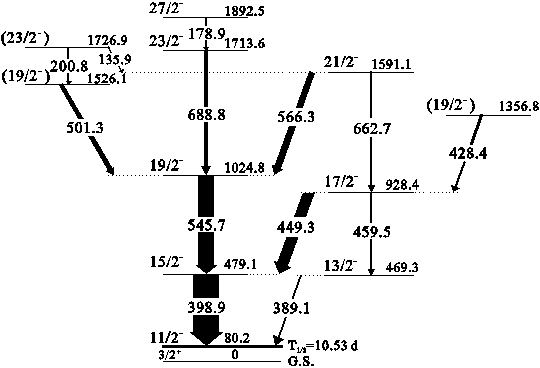Researchers in Institute of Modern Physics, Chinese Academy of Sciences(IMP)succeeded in studying high-spin states in stable nucleus 193Ir using the Joined in Beam Gamma Equipment of the HI-13MV Tandem Accelerator Laboratory at China Institute of Atomic Energy.
The nucleus 193Ir was produced in 192Os(7Li, α2n) reaction. Based on the analysis of γ-γ coincidence relationships, a new level scheme built on the πh11/2, 11/2- isomer in 193Ir has been proposed and presented in Fig. 1. Eleven new transitions were observed and eight new levels were added to the level scheme. The new band (see Fig. 1) in 193Ir has a structure consistent with an h11/2 proton coupled to a core of large triaxial deformation. The πh11/2 band structures have been discussed with the help of TRS calculations. It seems that the increasing signature splitting from 187Ir to 193Ir could be understood, at least qualitatively, as due to the decrease of quadrupole deformation and the increase of shape asymmetry. This increased shape asymmetry may occur as the position of neutron Fermi level moves away from the neutron midshell (N=104).
Osmium and iridium isotopes locate in the transitional region between the well-deformed rare earth nuclei and the spherical lead isotopes. These transitional nuclei show a rich variety of structures associated with significant variations of shape and deformation, and the γ degree of freedom plays an important role in describing these nuclei. The osmium nuclei in the A=190 mass region are believed to be γ-soft. When adding one proton to the γ-soft even-even osmium nuclei, such as the cases of odd-A iridium nuclei, the shape-polarizing effects of individual single particle in the high-j orbitals can reveal important clues for understanding the rotational spectra and their electromagnetic properties, hence serving as a probe of the nuclear shape.
The result has been published in Physical Review C 83, 054323 (2011).


